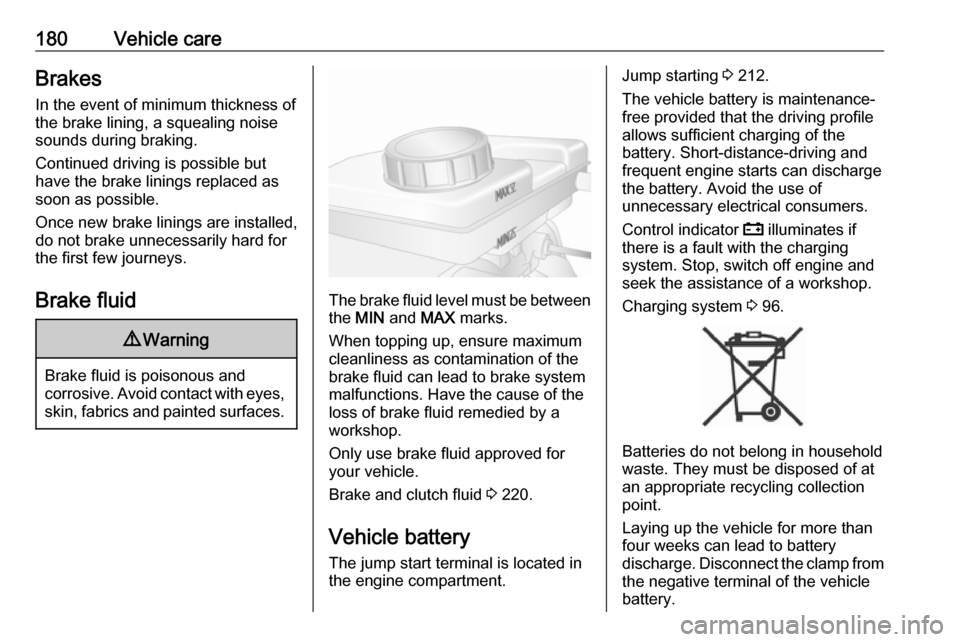2018 VAUXHALL MOVANO_B brakes
[x] Cancel search: brakesPage 18 of 261

16In briefTransmission
Manual transmission
Reverse: with the vehicle stationary,
depress clutch pedal and then pull up
the collar on the selector lever and
engage the gear.
If the gear does not engage, set the
lever to neutral, release the clutch
pedal and depress again; then repeat gear selection.
Manual transmission 3 149.
Manual transmission automatedN:neutralo:drive position+:higher gear-:lower gearA/M:switch between automatic and
manual modeR:reverse gear. Engage only
when vehicle is stationary.
Manual transmission automated
3 149.
Starting off
Check before starting off ● Tyre pressure and condition 3 199, 3 244.
● Engine oil level and fluid levels 3 176.
● All windows, mirrors, exterior lighting and number plates are
free from dirt, snow and ice and
are operational.
● Proper position of mirrors, seats and seat belts 3 35, 3 42,
3 52.
● Brake function at low speed, particularly if the brakes are wet.
Page 133 of 261

Driving and operating131Driving and
operatingDriving hints ............................... 132
Driving economically ...............132
Control of the vehicle ...............132
Steering ................................... 132
Starting and operating ...............133
New vehicle running-in ............133
Ignition switch positions ...........133
Starting the engine ..................134
Idle speed control ....................135
Overrun cut-off ........................ 135
Stop-start system ....................135
Parking .................................... 138
Air suspension ......................... 139
Engine exhaust .......................... 141
Diesel particle filter ..................141
Catalytic converter ...................141
AdBlue ..................................... 142
Manual transmission ..................149
Manual transmission automa‐ ted .............................................. 149
Transmission display ...............149
Starting the engine ..................150
Selector lever .......................... 150Manual mode........................... 151
Electronic driving programmes 151
Fault ........................................ 152
Interruption of power supply ....153
Brakes ........................................ 153
Antilock brake system .............153
Parking brake .......................... 154
Brake assist ............................. 155
Hill start assist ......................... 155
Ride control systems .................155
Traction Control system ..........155
Electronic stability program .....156
Limited-slip rear axle ...............158
Driver assistance systems .........158
Cruise control .......................... 158
Speed limiter ........................... 162
Parking assist .......................... 162
Rear view camera ...................164
Lane departure warning ..........166
Fuel ............................................ 167
Fuel for diesel engines ............167
Refuelling ................................ 168
Fuel consumption - CO 2-
Emissions .............................. 169
Trailer hitch ................................ 170
General information .................170
Driving characteristics and towing tips .............................. 170
Trailer towing ........................... 170Towing equipment ...................171
Trailer stability assist ...............171
Auxiliary features .......................171
Power take-off ......................... 171
Page 155 of 261

Driving and operating153Interruption of power supplyThe clutch is not disengaged if there
is an interruption of the power supply
when a gear is engaged. The vehicle
cannot move.
If the vehicle battery is discharged,
start the vehicle using jump leads
3 212.
If the cause of the fault is not a
discharged vehicle battery, seek the
assistance of a workshop.
If neutral cannot be selected, the
vehicle must only be towed with the
drive wheels raised off the ground
3 214.
Towing the vehicle 3 214.Brakes
The brake system comprises two
independent brake circuits.
If a brake circuit fails, the vehicle can
still be braked using the other brake
circuit. However, braking effect is
achieved only when you depress the
brake pedal firmly. You need to use
considerably more force for this. The
braking distance is extended. Seek
the assistance of a workshop before
continuing your journey.
When the engine is not running, the
support of the brake servo unit
disappears once the brake pedal has been depressed once or twice.
Braking effect is not reduced, but
braking requires significantly greater
force. It is especially important to bear this in mind when being towed.
Control indicator R 3 97.
Antilock brake system
Antilock brake system (ABS)
prevents the wheels from locking.ABS starts to regulate brake pressure as soon as a wheel shows a tendency
to lock. The vehicle remains
steerable, even during hard braking.
ABS control is made apparent
through a pulse in the brake pedal
and the noise of the regulation
process.
For optimum braking, keep the brake
pedal fully depressed throughout the
braking process, despite the fact that the pedal is pulsating. Do not reduce
the pressure on the pedal.
Control indicator u 3 97.
Fault
If control indicators u and A
illuminate with the messages CHECK
ABS and CHECK ESP in the Driver
Information Centre, there is a fault in
the ABS. The brake system remains
operational but without ABS
regulation.
Page 157 of 261

Driving and operating155Brake assistIf the brake pedal is depressed
quickly and forcefully, maximum
brake force is automatically applied
(full braking).
Maintain steady pressure on the
brake pedal for as long as full braking
is required. Maximum brake force is
automatically reduced when the
brake pedal is released.
Brake assist is not available during an
Autostop. Stop-start system 3 135.
Hill start assist The system helps prevent unintendedmovement when driving away on
inclines.
When releasing the brake pedal after
stopping on an incline (with the
selector lever in a forward gear or
reverse gear), the brakes remain on
for a further two seconds. The brakes release automatically as soon as the
vehicle begins to accelerate.Caution
The Hill start assist cannot
completely prevent vehicle
movement in all situations
(extremely steep gradients, etc.).
If necessary, depress the brake
pedal to prevent the vehicle from
rolling backwards.
The Hill start assist is not active
during an Autostop. Stop-start system 3 135.
Ride control systems
Traction Control system The Traction Control system (TC) is a
component part of the Electronic
Stability Program (ESP® Plus
) which
improves driving stability when
necessary, regardless of the type of
road surface or tyre grip, by
preventing the drive wheels from
spinning.
As soon as the drive wheels starts to spin, engine output is reduced and
the wheel spinning the most is braked
individually. This considerably
improves the driving stability of the
vehicle on slippery road surfaces.
TC is operational as soon as the
ignition is switched on and control
indicator b extinguishes in the
instrument cluster. A corresponding message also appears in the Driver
Information Centre 3 101.
When TC is active b flashes.
Page 172 of 261

170Driving and operatingTrailer hitch
General information
Only use towing equipment that has
been approved for your vehicle.
Entrust fitting of towing equipment at
a later date to a workshop. It may be
necessary to make changes that
affect the cooling system, heat
shields or other equipment.
Driving characteristics and towing tips
In the case of trailers with brakes,
attach the breakaway stopping cable.
Before attaching a trailer, lubricate
the coupling ball. However, do not do so if a stabiliser, which acts on thecoupling ball, is being used to reduce
snaking movements. For trailers with
low driving stability the use of a
stabiliser is recommended.
A maximum speed of 50 mph must
not be exceeded, even in countries
where higher speeds are permitted.If the trailer starts snaking, drive more slowly, do not attempt to correct the
steering and brake sharply if
necessary.
When driving downhill, drive in the
same gear as if driving uphill and
drive at a similar speed.
Adjust tyre pressure to the value
specified for full load 3 244.
Trailer towing
Trailer loads The permissible trailer loads are
vehicle-dependent and engine-
dependent maximum values which
must not be exceeded. The actual
trailer load is the difference between
the actual gross weight of the trailer
and the actual coupling socket load
with the trailer coupled.
The permissible trailer loads are
specified in the vehicle documents. In
general, they are valid for gradients
up to max. 12%.
The permitted trailer load applies up to the specified incline and up to an
altitude of 1000 metres above sealevel. Since engine power decreases
as altitude increases due to the air
becoming thinner, therefore reducing
climbing ability, the permissible gross
train weight also decreases by 10%
for every 1000 metres of additional
altitude. The gross train weight does
not have to be reduced when driving
on roads with slight inclines (less than 8%, e.g. motorways).
The permissible gross train weight
must not be exceeded. This weight is
specified on the identification plate
3 223.
Vertical coupling load
The vertical coupling load is the load
exerted by the trailer on the coupling
ball. It can be varied by changing the
weight distribution when loading the
trailer.
The maximum permissible vertical
coupling load is specified on the
towing equipment identification plate
and in the vehicle documents. Always aim for the maximum load, especially in the case of heavy trailers. The
vertical coupling load should never
fall below 25 kg.
Page 175 of 261

Vehicle care173Vehicle careGeneral Information...................174
Accessories and vehicle modifications .......................... 174
Vehicle storage ........................174
End-of-life vehicle recovery .....175
Vehicle checks ........................... 175
Performing work ......................175
Bonnet ..................................... 175
Engine oil ................................. 176
Engine coolant ......................... 178
Power steering fluid .................178
Washer fluid ............................ 179
Brakes ..................................... 180
Brake fluid ............................... 180
Vehicle battery ......................... 180
Diesel fuel filter ........................182
Diesel fuel system bleeding .....183
Wiper blade replacement ........183
Bulb replacement .......................184
Headlights ............................... 184
Adaptive forward lighting .........187
Fog lights ................................. 187
Front turn signal lights .............187
Tail lights ................................. 188
Side turn signal lights ..............190Centre high-mounted brake
light ......................................... 190
Number plate light ...................191
Interior lights ............................ 192
Instrument panel illumination ...193
Electrical system ........................193
Fuses ....................................... 193
Engine compartment fuse box . 194
Instrument panel fuse box .......195
Load compartment fuse box ....196
Vehicle tools .............................. 198
Tools ........................................ 198
Wheels and tyres .......................199
Tyres ....................................... 199
Winter tyres ............................. 199
Tyre designations ....................199
Tyre pressure .......................... 199
Tyre pressure monitoring system .................................... 200
Tread depth ............................. 202
Changing tyre and wheel size . 203 Wheel covers ........................... 203
Tyre chains .............................. 203
Tyre repair kit .......................... 204
Wheel changing .......................207
Spare wheel ............................ 209
Jump starting ............................. 212Towing....................................... 214
Towing the vehicle ...................214
Towing another vehicle ...........215
Appearance care .......................216
Exterior care ............................ 216
Interior care ............................. 218
Page 182 of 261

180Vehicle careBrakesIn the event of minimum thickness of
the brake lining, a squealing noise
sounds during braking.
Continued driving is possible but
have the brake linings replaced as
soon as possible.
Once new brake linings are installed,
do not brake unnecessarily hard for
the first few journeys.
Brake fluid9 Warning
Brake fluid is poisonous and
corrosive. Avoid contact with eyes, skin, fabrics and painted surfaces.
The brake fluid level must be betweenthe MIN and MAX marks.
When topping up, ensure maximum cleanliness as contamination of the
brake fluid can lead to brake system
malfunctions. Have the cause of the
loss of brake fluid remedied by a
workshop.
Only use brake fluid approved for
your vehicle.
Brake and clutch fluid 3 220.
Vehicle battery
The jump start terminal is located in
the engine compartment.
Jump starting 3 212.
The vehicle battery is maintenance-
free provided that the driving profile
allows sufficient charging of the
battery. Short-distance-driving and
frequent engine starts can discharge
the battery. Avoid the use of
unnecessary electrical consumers.
Control indicator p illuminates if
there is a fault with the charging
system. Stop, switch off engine and
seek the assistance of a workshop.
Charging system 3 96.
Batteries do not belong in household
waste. They must be disposed of at
an appropriate recycling collection
point.
Laying up the vehicle for more than
four weeks can lead to battery
discharge. Disconnect the clamp from the negative terminal of the vehicle
battery.
Page 254 of 261

252IndexAAbsorptive Glass Mat battery .....180
Accessories and vehicle modifications .......................... 174
Adaptive forward lighting ...110, 187
AdBlue .......................... 98, 142, 220
AdBlue gauge ............................... 90
AdBlue tank ................................ 243
Adjustable air vents ...................128
Airbag and belt tensioners ...........95
Airbag deactivation ................59, 95
Airbag label................................... 55 Airbag system .............................. 55
Air conditioning regular operation ................................ 129
Air conditioning system .............. 116
Air intake .................................... 129
Air suspension ........................... 139
Air suspension system................ 214
Air vents...................................... 128
Antifreeze ................................... 178
Antilock brake system ................ 153
Antilock brake system (ABS) .......97
Anti-theft alarm system ................32
Anti-theft bolts............................. 207
Anti-theft locking system .............. 32
Anti-theft security lock ..................21
Appearance care ........................216
Armrest ........................................ 47
Ashtrays ....................................... 88Automatic light control ...............107
Automatic locking ...................22, 26
Autostop ....................... 16, 134, 135
Auxiliary heater ........................... 122
B Battery ........................................ 180
Battery discharge protection ......114
Battery, jump starting.................. 212
Belts.............................................. 51
BlueInjection ............................... 142
Bonnet ....................................... 175
Bottle holders................................ 72
Brake assist ............................... 155
Brake fluid .......................... 180, 220
Brakes ............................... 153, 180
Brake system ............................... 97
Breakdown.................................. 214
Bulb replacement ....................... 184
Bus Rear seats ................................. 48
C Cabin bulkhead grille ....................78
Capacities .................................. 243
Cargo management system ........75
Car Pass ...................................... 20
Catalytic converter .....................141
Central locking system ................22
Centre high-mounted brake light 190
Changing tyre and wheel size ...203